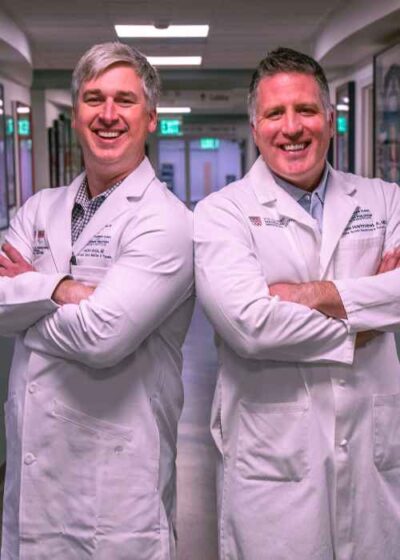Achilles Tendon Specialists
Are you an athlete who participates in skiing, snowboarding, or other similar sports? If so, you may be at an increased risk of developing an Achilles tendon injury, such as an Achilles rupture. Achilles ruptures cause decreased strength in the ankle and may require surgery to repair. Foot and ankle specialists, Doctors Thomas Haytmanek and Jonathon Backus have diagnosed and treated many patients in Vail, Aspen, and the surrounding Denver, Colorado communities who have experienced an Achilles rupture. If you believe you may have injured your Achilles tendon, contact The Steadman Clinic’s Sports Foot and Ankle team today!

What is an Achilles Tendon Injury?
An Achilles tendon rupture often happens during loading of the Achilles tendon when the foot is suddenly pushed upward. This often happens playing tennis, basketball, or other sports that require backpedaling. In skiing, it occurs when the skier goes over the front of his or her skis without the heel releasing and the ankle is forced in an upward direction. A similar scenario is found when a snowboarder’s landing deflects the board upward and the motion abruptly forces the foot and ankle upward, overstretching the Achilles tendon. Patients usually describe a pop and pain in the posterior heel and feel as if they were kicked in the posterior ankle. Rupture of the Achilles tendon leads to pain and decreased push-off strength. Achilles tendon injuries are common to both “weekend warriors” and high-level athletes. There is an association with oral antibiotic use from the category known as fluoroquinolone (e.g. ciprofloxacin (Cipro) or levofloxacin (Levaquin) and steroid usage; users of these medications, separately or together, may be more susceptible to an Achilles tendon rupture.
What are Achilles Rupture Symptoms?
Patients with an Achilles tendon rupture complain of pain in the posterior ankle as well as decreased strength when pushing off during gait. Some patients are unable to walk at all. Others retain the ability to flex the ankle with the use of the other flexor tendons, including the flexor hallucis longus and the flexor digitorum longus muscles.
How is an Achilles tendon injury diagnosed?
A thorough evaluation after an Achilles tendon rupture is important. The diagnosis can usually be made clinically, without the use of advanced imaging modalities such as MRI. The patient usually has a palpable gap at the area of the Achilles tendon rupture. While ruptures are usually located 2-3 inches above the Achilles attachment to the heel bone, the rupture occasionally tears off at its attachment to the heel bone (calcaneus) – termed an insertional rupture. A Thompson test is utilized to confirm the diagnosis of an Achilles tendon rupture. The test is done by laying a patient on his or her belly and squeezing the calf. If the tendon is intact, there is brisk downward movement (plantar flexion) of the foot. On the other hand, if the tendon is ruptured, there is no motion of the foot when the calf muscle is squeezed. X-rays are sometimes required to confirm that there has been no avulsion, or bone being pulled off of the heel bone.
What is the treatment for a ruptured Achilles tendon?
Once the diagnosis has been confirmed as an acute rupture of the tendon in its mid-substance, treatment can be determined. Both operative and nonoperative solutions are possible. In general, younger, healthy, and more athletic individuals are typically treated surgically while older, unhealthy, and less active patients are treated non-operatively. Surgical treatment involves making a small incision and repairing the tendon with suture, and non-operative treatment places a patient in a cast with the foot in a downward position. Both forms of treatment can be effective, but surgery results in earlier resumption of weight bearing, motion, and ability to ambulate and gain strength. Surgical patients return to work or sports participation with less risk of re-rupture. Non-operative treatment, on the other hand, has less risk of infection and the other complications related to surgery yet still produces a good clinical outcome at 1 year that is comparable to that of surgical repair. The single biggest risk with non-operative treatment is that of a re-rupture, which is 2-3 times that of an Achilles tendon treated surgically. The best treatment option is determined by an open discussion with the patient about individual recovery goals, as well as risks and benefits of each procedure.